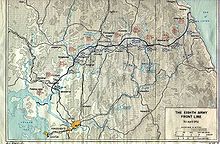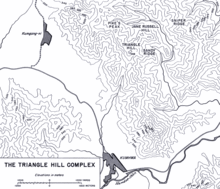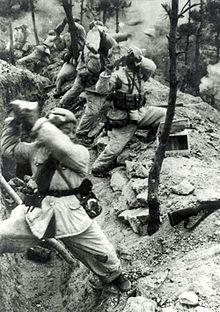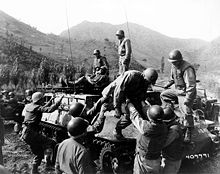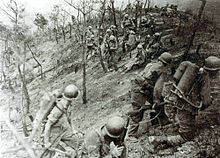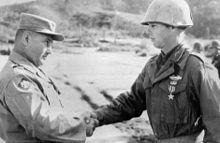- Battle of Triangle Hill
-
This article is about Battle of Shangganling in the Korean War. For the Chinese war film made in 1956, see Battle on Shangganling Mountain.
Battle of Triangle Hill Part of the Korean War 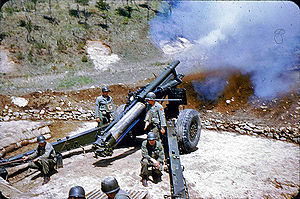
US Army 155mm howitzer firing on Triangle HillDate October 14 – November 25, 1952 Location Kimhwa, Korea Result Chinese victory on Triangle Hill;
Both China and South Korea claim victory on Sniper Ridge[1][nb 1]Belligerents  United Nations
United Nations
 China
ChinaCommanders and leaders  Mark Wayne Clark
Mark Wayne Clark
 James Van Fleet
James Van Fleet
 Reuben E. Jenkins
Reuben E. Jenkins
 Wayne C. Smith
Wayne C. Smith
 Chung Il-kwon
Chung Il-kwon Deng Hua
Deng Hua
 Wang Jinshan[2]
Wang Jinshan[2]
 Qin Jiwei
Qin Jiwei
 Li Desheng[3]
Li Desheng[3]
 Cui Jiangong
Cui JiangongUnits involved  7th Infantry Division
7th Infantry Division
 2nd Infantry Division
2nd Infantry Division
 30th Infantry Regiment
30th Infantry Regiment
 2nd Kagnew Battalion[4]
2nd Kagnew Battalion[4]
 Colombian Battalion[5]
Colombian Battalion[5] 15th Corps[nb 2]
15th Corps[nb 2]
 12th Corps
12th CorpsStrength Infantry: Unknown
Artillery: 288 guns[6]
Aircraft: 2,200+ sorties[7]Infantry: 50,000[8]
Artillery: 133 guns, 24 rocket launchers
AA Artillery: 47 guns[9]Casualties and losses US:
365 killed
1,174 wounded
1 captured[10]
South Korea:
1,096 killed
3,496 wounded
97 missing[11]
Chinese estimation:
25,498[12]Chinese source:
4,838 killed
6,691 wounded[13]
UN estimation:
19,000[14]- Ongjin
- Kaesong-Munsan
- Gorangpo
- Dongducheon
- Pocheon
- Chuncheon
- Gangneung
- Gimpo
- Okgye
- Korea Strait
- Uijeongbu
- Naechon-Taereung
- Changdong
- Bongilcheon
- Miari
- Hongcheon
- Han River
- Oryudong
- Sinsadong-Gwacheon
- Uljin-Pyeonghae
- Siheung-Anyang-Suwon)
- Jumunjin
- Air campaign
- Suwon Airfield
- Osan
- Pyongtaek
- Chonan
- Chochiwon
- Donglakri
- Danyang
- Jincheon
- Yihwaryeong
- Taejon
- Sangju
- Yeongdeok
- Yongdong
- Hwanggan
- Hwaryeongjang
- Younggang
- Andong
- Hadong
- The Notch
August Offensive
- Pusan Perimeter
- Haeju
- Inchon
- 2nd Seoul
- Hill 282
- Kaesong
- Operation Wonsan
- Wonsan
- Hungham
- Yongju
- Yeonghung
- Kumchon
- Pyongyang
- Huichon
- Chongju
- Chosan
Chinese intervention
- Onjong
- Unsan
- Pakchon
- Ch'ongch'on River
- Wawon
- Chosin Reservoir
- Task Force Faith
- 3rd Seoul
- 1st and 2nd Wonju
- Thunderbolt
- Twin Tunnels
- Roundup
- Hoengsong
- Chipyong-ni
- 3rd Wonju
- Killer
- 4th Seoul
- Courageous
- Tomahawk
- Rugged and Dauntless
- 5th Seoul (Imjin River
- Yultong
- Kapyong)
- Soyang River
Stalemate
- Bloody Ridge
- Han River
- Heartbreak Ridge
- Maryang San
- Sunchon
- Hill Eerie
- Sui-ho Dam
- Old Baldy
- Blaze
- Hudson Harbor
- White Horse
- Triangle Hill
- Jackson Heights
- The Hook
- Pork Chop Hill
- Outpost Harry
- Kumsong
- Samichon River
Post Armistice
- Korean DMZ Conflict (1966–1969)
- Blue House Raid
- Pueblo incident
- EC-121 shootdown
- Major Henderson incident
- Axe murder incident
- Rangoon bombing
- KAL Flight 858
- Gangneung
- Yosu
- 1st Yeonpyeong
- 2nd Yeonpyeong
- Daecheong
- Cheonan incident
- 3rd Yeonpyeong
The Battle of Triangle Hill, also known as Operation Showdown or the Shangganling Campaign (Chinese: 上甘岭战役; pinyin: Shàng Gān Lǐng Zhàn Yì),[nb 3] was a protracted military engagement during the Korean War. The main combatants were two United Nations infantry divisions, with additional support from the United States Air Force, against elements of the 15th and 12th Corps[nb 2] of the People's Republic of China. The battle was part of American attempts to gain control of "The Iron Triangle", and took place from October 14 – November 25, 1952.
The immediate American objective was Triangle Hill (38°19′17″N 127°27′52″E / 38.32139°N 127.46444°ECoordinates: 38°19′17″N 127°27′52″E / 38.32139°N 127.46444°E), a forested ridge of high ground 2 kilometers (1.2 mi) north of Kimhwa near the Korean Demilitarized Zone (DMZ). The hill was occupied by the veterans of the People's Volunteer Army's 15th Corps. Over the course of nearly a month, substantial American and South Korean forces made repeated attempts to capture Triangle Hill and the adjacent Sniper Ridge. Despite clear superiority in artillery and aircraft, escalating American and South Korean casualties resulted in the attack being halted after 42 days of fighting, with Chinese forces regaining their original positions.
Contents
Background
By mid-1951 the Korean War had entered a period of relative stalemate.[15] With the resignation of Dwight D. Eisenhower as the Supreme Commander of the North Atlantic Treaty Organization (NATO) in June 1952, General Matthew Ridgway of the United Nations Command was transferred from Korea to Europe as Eisenhower's replacement.[16] The United States Army appointed General Mark Wayne Clark, commander of the US Fifth Army during World War II, to overall command on the Korean Peninsula as a replacement for Ridgway.[16]
General James Van Fleet of the Eighth United States Army had hoped that the change of commanders would allow him to reengage the Chinese in a major campaign,[17] but in an effort to sustain the ongoing peace talks in Panmunjom, Clark repeatedly overruled Van Fleet's requests for an authorized offensive into North Korean territory.[17] In September 1952, Van Fleet submitted tentative offensive plans for Operation Showdown, a small-scale offensive drafted by the US IX Corps as a ridge-capturing operation. The goal of the submitted plans was to improve the defensive line of the US 7th Infantry Division north of Kimhwa near Triangle Hill, pushing the Chinese defensive line back 1,250 yd (1,140 m).[18]
In September 1952, the negotiations at Panmunjom began to fall apart, primarily due to Sino-Korean insistence that all prisoners of war be repatriated to their respective original countries, regardless of their personal preferences.[19] As a significant number of Chinese and North Korean POWs had expressed their desire to defect permanently to South Korea or Taiwan, the demand was met with strong opposition from the United States and South Korea.[15] Feeling that the negotiations would soon fail, military commanders on both sides authorized numerous tactical plans as means of applying pressure on their opponents.[20] In late September, the High Command of the Chinese People's Volunteer Army (PVA) authorized the tactical plans which led to the Battle of White Horse.[21] On October 8, 1952, truce negotiations officially ceased. Clark gave his consent to Operation Showdown the same day.[22]
Prelude
Locations and terrain
Triangle Hill, as it was named by the American command, is a forested hill that appears as a V shape when seen from the air or on a map. Located at 38°19′17″N 127°27′52″E / 38.32139°N 127.46444°ECoordinates: 38°19′17″N 127°27′52″E / 38.32139°N 127.46444°E, Hill 598 sits at the tip of the V and overlooks the Kimhua valley less than 2 km (1.2 mi) to the South. From this apex, two ridges extend to the northeast and northwest. The ridge to the northwest is dominated by a hill nicknamed Pike's Peak. The other connect to a pair of hills that had been dubbed Jane Russell. A less prominent ridge, named Sandy, slopes down to the east. Across the valley from Sandy stands Sniper Ridge, located at 38°19′44″N 127°29′7″E / 38.32889°N 127.48528°E.[23]
Forces and strategies
The original plan for Operation Showdown called for simultaneous attacks on both Triangle Hill and Sniper Ridge. One battalion from the 31st Infantry Regiment of the US 7th Infantry Division would take Triangle Hill from Kimhwa, while one battalion from the 32nd Regiment of the Republic of Korea (ROK) 2nd Infantry Division would attack Sniper Ridge along a parallel northbound route. UN planners expected the operation to last no more than five days with 200 casualties on the UN side, based on the assumption that maximum artillery and air support would be available.[22][23] Before the plan could be carried out, however, the artillery and air assets for this operation were diverted to the fighting at White Horse.[23] Upon reviewing the situation, Colonel Lloyd R. Moses, commander of the US 31st Infantry Regiment, doubled the American strength just before the offensive.[24]
On the Chinese side, Triangle Hill was defended by the 8th and 9th Companies,[25] and Sniper Ridge by the 1st Company of the 15th Corps' 135th Regiment, 45th Division.[26] Qin Jiwei,[nb 4] commander of the 15th Corps, predicted that any major American attack would be one of mechanized infantry and armor directed at the Pyonggang Valley 20 km (12 mi) to the west of Triangle Hill.[27] As a result, the primary formations of the 15th Corps, including the 44th Division, the 29th Division, one armored regiment and most of the corps artillery, were positioned near Pyonggang.[28] In an effort to compensate its inferior firepower, the 15th Corps constructed an intricate series of defensive networks, which were composed of 9,000 meters (9,800 yd) of tunnels, 50,000 meters (55,000 yd) of trenches and 5,000 meters (5,500 yd) of obstacles and minefields.[29] On October 5, 1952, a staff officer of the ROK 2nd Infantry Division defected to Chinese forces, bringing with him a complete battle plan of Operation Showdown, but the information was not taken seriously by the Chinese.[30]
Battle
Opening moves
On October 14, 1952 at 4 am, following two days of preliminary air strikes,[23] the Korean-American bombardment intensified across the 30 km (19 mi) front held by the Chinese 15th Corps. At 5 am, the 280 guns and howitzers of the IX Corps extended their firing range to allow for the Korean-American infantry to advance behind a rolling barrage.[31] The concentrated bombardment succeeded in clearing the foliage on Triangle Hill and Sniper Ridge, destroying most of the above-ground fortifications on the two positions.[31] The intense shelling also disrupted Chinese communication lines, eliminating all wired and wireless communications in the area.[32]
As the American and South Korean forces approached the Chinese defenses, they were met with grenades, Bangalore torpedoes, shaped charges and rocks.[33][34] Unable to safely advance, American and South Korean troops were forced to rely on close-support artillery to subdue Chinese resistance,[33][34] but a complex network of bunkers and tunnels allowed the Chinese to bring up reinforcements as the above-ground troops were depleted.[34][35] Although the 31st Infantry Regiment was equipped with ballistic vests in the first mass military deployment of modern personal armor;[10] its 1st and 3rd battalions nevertheless suffered 96 fatalities, with an additional 337 men wounded in the first attack – the heaviest casualties the 31st Infantry Regiment had suffered in a single day during the war.[10][36]
The Chinese managed to inflict heavy casualties on the attackers, but their defenses were starting to give way under devastating UN firepower. The defending company of Sniper Ridge was forced to withdraw into the tunnels after it was reduced to 20 survivors,[37] and the ROK 2nd Battalion captured the ridge by 3:20 pm.[31] Despite the acquisition of Sniper Ridge, the attack on Triangle Hill stalled in front of the dominant Hill 598 as both American battalions suffered heavy casualties to Chinese grenades. When only partial progress could be claimed by the late afternoon, US and ROK attacks subsided and preparation of defensive positions to face a Chinese counterattack began.[38]
To recover lost ground, the PVA 45th Division commander Cui Jiangong attempted a sneak attack with three infantry companies by 7 pm.[39] When flares broke the night cover, the attackers launched bayonet charges and hand-to-hand fighting ensued.[34][38][40] The UN forces responded with heavy artillery fire, but the determined Chinese assault troops marched through both Chinese and UN artillery screens to reach the UN positions – a strange sight that made some American observers believe that the attackers were under the influence of drugs.[38][41] The intense fighting prevented UN forces from receiving any resupply,[38] and the UN defenders were forced to give up all captured ground after running out of ammunition.[34][38]
Taking the surface
Both Major General Wayne C. Smith and Lieutenant General Chung Il-kwon, commanders of the US 7th Infantry Division and the ROK 2nd Infantry Division respectively, relieved exhausted battalions daily to maintain troops' morale.[42] On October 15, Smith ordered the 1st Battalion of the US 32nd Infantry Regiment and the 2nd Battalion of the US 31st Infantry Regiment to be placed under the command of Colonel Moses to resume the attack on Triangle Hill.[38] Similarly, Chung Il-kwon replaced the 2nd Battalion of the ROK 32nd Regiment with the 2nd Battalion of the ROK 17th Regiment.[34] Later that day both US battalions captured Hill 598 and Sandy Ridge after meeting only light resistance, but the Chinese tunnels and a counterattack by the PVA 135th Regiment prevented the Americans from advancing towards Pike's Peak and Jane Russell Hill.[43] The South Koreans, on the other hand, were thrown back by a Chinese counterattack after recapturing Sniper Ridge.[34]
On October 16, Colonel Joseph R. Russ of the US 32nd Infantry Regiment took over the operational command from Moses. He was also given the 2nd Battalion of the US 17th Infantry Regiment to reinforce his right wing.[44] After arriving on the battlefield, the US 2nd Battalion managed to wrestle Jane Russell Hill away from the Chinese on October 16,[41] but the Americans soon came under heavy fire from Chinese machine guns in the valley below, and were forced to withdraw to the slope behind the hill on October 18.[45] The Chinese continued to harass the American positions with small raiding parties and grenade barrages throughout that night.[45] The Koreans fared somewhat better. A joint attack by 2nd Battalion of the ROK 17th Regiment and the 2nd Battalion of the ROK 32nd Regiment captured Sniper Ridge and held it against subsequent Chinese counterattacks.[34] For the first time since the combat began, UN forces had gained firm control of the surface, with the exception of Pike's Peak.[44] On the afternoon of October 17, the 3rd Battalion of the US 17th Infantry Regiment relieved the 2nd Battalion of the US 31st Infantry Regiment on the left wing, while the 1st Battalion of the US 32nd Infantry Regiment was withdrawn from the pacified center.[44]
For Qin Jiwei, the lack of functioning communication networks and accurate intelligence prevented him from responding to the UN assaults.[46] Because of his indecision, the 45th Division also received no artillery support against the UN attacks.[47] In the face of devastating UN firepower, the Chinese defenders suffered 500 casualties per day during the initial UN onslaught.[47] On October 17, after learning that more than 10 Chinese infantry companies were rendered combat ineffective, Cui Jiangong committed the remaining six infantry companies to a last ditch counterattack.[48] Aided by 44 large-caliber guns and a regiment of BM-13 rocket launchers,[49] the elite 8th Company of the 134th Regiment attacked from the tunnels under Hill 598 while the other five infantry companies attacked across open ground at dusk on October 19.[50] Their left wing drove the Koreans off Sniper Ridge,[34] but the US defenders on Triangle Hill held firm.[51] At daybreak on October 20, UN firepower regained the upper hand and the Chinese were forced back into the tunnels after suffering heavy casualties.[52][53] By the time Smith replaced the US 17th Infantry Regiment with the US 32nd Infantry Regiment on the afternoon of October 20,[52] Qin Jiwei received reports that the 45th Division was completely decimated.[54] The Chinese attacked Hill 598 again on the night of October 23 with two infantry companies,[55] but the well entrenched US troops beat back the attack with little difficulty.[52]
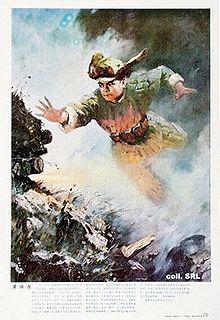 According to the Chinese government, the Chinese hero Huang Jiguang (黄继光烈士) used his own body to block machine gun fire during the battle.[56]
According to the Chinese government, the Chinese hero Huang Jiguang (黄继光烈士) used his own body to block machine gun fire during the battle.[56]
After suffering over 4,000 casualties in ten days, the failure of the last attack ended the 45th Division's role as the only combatant on the Chinese side.[57] The UN forces had gained strong control over most of the area, with the remaining Chinese defenders trapped in tunnels under the UN positions.[58] Despite the initial setbacks, Deng Hua, acting commander of the PVA, considered the situation a golden opportunity to bleed the US military white.[59][60] In the strategy meeting held on the evening of October 25, the 15th Corps was ordered to retake the two hills regardless of the cost.[60]
Interlude
Van Fleet decided to rest the US 7th Infantry Division on October 25, thus sidestepping the Chinese intention of inflicting additional casualties on the Americans. The 31st Regiment of the ROK 2nd Infantry Division would take over the Triangle Hill area while the 17th Regiment of the ROK 2nd Infantry Division maintained control over Sniper Ridge.[4][52] On the same day, fresh Chinese reinforcements were converging on the Kimhwa front. The PVA High Command ordered the 12th Corps to be placed under the command of the 15th Corps and Qin Jiwei ordered the 86th and 87th Regiments of the 29th Division to link up with the 45th Division for a new counterattack.[61] The 45th Division also received 1,200 new recruits to reconstitute 13 of its infantry companies.[62] About 67 heavy guns and one regiment of anti-aircraft artillery were made available to support the upcoming counterattack.[61][63] All Chinese reinforcements were focused on Triangle Hill, with Sniper Ridge considered secondary.[64]
Over the next five days, the ROK 31st Regiment was involved in a bitter struggle with the Chinese defenders underground.[4] The PVA 45th Division had also infiltrated small units into UN positions every night to resupply the trapped units and to evacuate the wounded, causing heavy casualties among the Chinese logistics and medical units.[65] As there was no battalion level combat between October 20 and October 29, the Chinese were able to gather their strength for a decisive blow.[66]
Escalation
Before the start of the battle, Qin Jiwei had worried that Van Fleet would try to lure the Chinese forces around Triangle Hill, with the real blow directed towards the Pyongyang Valley.[30] To counter this possibility, the 44th Division and the 85th Regiment of the 29th Division had been conducting preemptive attacks on Jackson Heights since early October.[30][67] From mid October, the 44th Division increased the strength of its attacks in an effort to relieve pressure from Triangle Hill,[68] and the battle of attrition that was witnessed over Triangle Hill had also developed at Jackson Heights.[69]
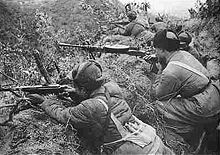 A squad of Chinese infantrymen in defensive position on Triangle Hill. The machine-gunner is armed with a Degtyaryov.
A squad of Chinese infantrymen in defensive position on Triangle Hill. The machine-gunner is armed with a Degtyaryov.
At noon on October 30, the 15th Corps bombarded the Koreans with 133 large-caliber guns, 22 rocket launchers and 30 120 mm heavy mortars in the largest Chinese artillery operation of the Korean War.[70] When the bombardment ended at midnight, 10 infantry companies from the 45th and the 29th Divisions[71] swarmed over the ROK 31st Regiment's positions and pushed the Koreans off the summit.[4] In the aftermath of the fighting, only 175 Koreans survived the onslaught out of the three defending infantry companies.[72] With the PVA 91st Regiment of the 31st Division, 12th Corps, arriving as reinforcement on November 1,[73] the Chinese forces chased the remaining Korean defenders off Jane Russell Hill and beat off the subsequent counterattack.[42][nb 5] Responding to the losses, the US IX Corps ordered the ROK 30th Regiment of the ROK 9th Infantry Division to take back Triangle Hill on October 31.[4] The South Koreans launched continuous attacks for the next five days to no avail.[4][nb 5] Although the Koreans failed to recapture the hill, the resulting heavy casualties forced the Chinese to call in the 93rd Regiment of the 31st Division as reinforcement on November 5.[74] On the same day, Lieutenant General Reuben E. Jenkins, commander of the US IX Corps, suspended further attacks on Triangle Hill to prevent more casualties and to protect Sniper Ridge.[4][42]
As the IX Corps gave up on Triangle Hill, the PVA 31st Division of the 12th Corps was in position to take back Sniper Ridge.[75] Under the cover of inclement weather, an assault was launched by the 92nd Regiment at 4 pm on November 11.[76][77] The Chinese soon drove off the defending 1st Battalion of the ROK 32nd Regiment, but Chung Il-kwon immediately replied with a counterattack by the ROK 17th Regiment of the ROK 2nd Infantry Division on the dawn of November 12. After two hours of fighting, the 1st Battalion of the ROK 17th Regiment recaptured two-thirds of Sniper Ridge and inflicted heavy casualties on the PVA 92nd Regiment.[76] The 31st Division relieved the 92nd Regiment with its 93rd Regiment to launch another assault on November 14,[78] but the ROK 17th Regiment responded by committing all units to blunt the attack. By November 17, with the help of the ROK 1st Field Artillery Group, the ROK 2nd Battalion returned to the 1st Battalion's original position after a two-hour battle.[42][79] Undeterred by heavy casualties, the PVA 106th Regiment of the 34th Division, 12th Corps relieved the weakened 93rd Regiment during the night of November 18.[80] For the next six days, 'seesaw' fighting continued on Sniper Ridge. By November 25, the ROK 2nd Infantry Division was relieved by the ROK 9th Infantry Division on Sniper Ridge and the fighting finally died down.[11]
Conclusion
Given the high numbers of UN casualties and under pressure from Clark, Van Fleet broke off Operation Showdown on November 28, thus ending the Battle of Triangle Hill.[59] A few days later, the PVA 34th Division and the ROK 9th Infantry Division were engaged in a seesaw battle on Sniper Ridge on December 2 and 3, and it failed to produce any territorial gains for either side.[81] On December 15, with the PVA 29th Division taking over the control of the battlefield from the 34th Division, the 12th Corps withdrew from the area and the 15th Corps settled back to the status quo prior to October 14.[82][nb 1]
Aftermath
The Battle of Triangle Hill was the biggest and bloodiest contest of 1952.[11] After 42 days of heavy fighting, the Eighth Army had failed to gain the two hill masses that were its original goal.[83] For the Chinese, on the other hand, not only did the 15th Corps stop the UN attacks at Triangle Hill, the assaults conducted by the 44th Division on the Pyongyang front also resulted in Jackson Heights' capture on November 30.[84] Although the Chinese had suffered 11,500 casualties with many units decimated during the battle, its ability to sustain such losses had slowly exhausted the US Eighth Army over two months of attrition.[59] The PVA High Command viewed the victory as vindication that attrition was an effective strategy against the UN forces,[85] while the Chinese became more aggressive on the armistice negotiation and the battlefield.[86] Meanwhile, the high UN casualties forced Clark to suspend any upcoming offensive operations involving more than one battalion, effectively preventing any major UN offensives for the rest of the war.[87][88] Clark and US President Harry S. Truman later confided that the battle was a serious blow to the UN morale.[85] As for the South Koreans, the modest UN gain on Sniper Ridge had convinced them that the South Korean armed forces were now capable of conducting independent offensive operations,[1] even through the American advisers were less than impressed with their performance during the course of the battle.[85]
Despite its impact and scale, the Battle of Triangle Hill is one of the least known episodes of the Korean War within the Western media.[85] But for the Chinese, this costly victory presented an opportunity to promote the value of endurance and sacrifice.[9] The valor demonstrated by the Chinese soldiers at Triangle Hill was repeatedly glorified in various forms of media, including several major motion pictures.[89] Qin Jiwei was also celebrated as the hero of Shangganling and eventually rose to become the Minister of Defense and the Vice Chairman of the National People's Congress.[90][91] The 15th Corps became one of the most prestigious units within the PLA, and the PLAAF selected the 15th Corps to become China's first airborne corps in 1961.[92] It remains the most elite corps-size unit in China today.[93]
Notes
- Footnotes
- ^ a b There is a discrepancy between South Korean and Chinese records on their starting locations with regards to Sniper Ridge. Sniper Ridge is composed of two peaks on both the north and the south ends of the ridge. According to Chinese records, the PVA occupied the northern peak only, with UN units already controlling the southern peak at the start of the battle. South Korean records list the southern peak as its main battle objective, with the Chinese controlling the entire ridge.
- ^ a b In Chinese military nomenclature, the term "Army" (军) means Corps.
- ^ Chinese sources often mistranslate Shangganling Campaign as the Battle of Heartbreak Ridge.
- ^ The Chinese military did not have military ranks until 1955.
- ^ a b Chinese records diverge greatly from October 30 to November 5, claiming that in addition to the ROK 30th Regiment, US 187th Regimental Combat Team was also present during this phase of the battle.
- Citations
- ^ a b Chae, Chung & Yang 2001, pp. xi, 473.
- ^ Chinese Military Science Academy 2000, p. 568.
- ^ Chinese Military Science Academy 2000, p. 569.
- ^ a b c d e f g Chae, Chung & Yang 2001, p. 470.
- ^ Martinez, Guadalupe A. (2009-01). "The Colombians’ Role in the Battle for Triangle Hill (Hill 598)" (PDF). The Graybeards (Charleston, IL: Korean War Veterans Association) 23 (1): 30–31, 63. http://www.kwva.org/graybeards/gb_09/gb_0902/gb_0902_final.pdf. Retrieved 2009-06-04.
- ^ Edwards 2005, p. 170.
- ^ Hermes 1992, p. 328.
- ^ Zhang 2010, p. 288.
- ^ a b Chinese Military Science Academy 2000, p. 304.
- ^ a b c Ecker, Richard (2002-09). "Showdown on Triangle Hill: Twelve Days of Intense Combat in October 1952 Cost the U.S. 7th Infantry Division 365 KIA for a Piece of Turf that Ultimately Remained in Enemy Hands". Washington, D.C: VFW Magazine. http://findarticles.com/p/articles/mi_m0LIY/is_1_90/ai_91914493/?tag=mantle_skin;content. Retrieved 2009-02-05.
- ^ a b c Chae, Chung & Yang 2001, p. 472.
- ^ Zhang 2010, p. 290.
- ^ Zhang 2010, p. 285.
- ^ Hermes 1992, p. 318.
- ^ a b Millett, Allan R. (2009). "Korean War". Encyclopædia Britannica. http://www.britannica.com/EBchecked/topic/322419/Korean-War. Retrieved 2009-02-04.
- ^ a b "NATO: Change of Command". TIME magazine (New York, NY: Time Inc.). 1952-05-05. http://www.time.com/time/magazine/article/0,9171,820756,00.html. Retrieved 2011-07-25.
- ^ a b Hermes 1992, p. 292.
- ^ Tucker et al. 2000, p. 650.
- ^ Hermes 1992, p. 279.
- ^ Hermes 1992, p. 282.
- ^ Chinese Military Science Academy 2000, p. 271.
- ^ a b Chae, Chung & Yang 2001, p. 466.
- ^ a b c d Hermes 1992, p. 311.
- ^ Hermes 1992, p. 312.
- ^ Zhang 2010, p. 84.
- ^ Zhang 2010, p. 89.
- ^ Zhang 2010, pp. 42, 68.
- ^ Zhang 2010, p. 42.
- ^ Zhang 2010, p. 59.
- ^ a b c Zhang 2010, p. 68.
- ^ a b c Chae, Chung & Yang 2001, p. 467.
- ^ Zhang 2010, p. 76.
- ^ a b Hermes 1992, p. 313.
- ^ a b c d e f g h i Chae, Chung & Yang 2001, p. 469.
- ^ Zhang 2010, p. 86.
- ^ Borkowski, Walt (2001-09-13). "Oral History Interview - Thomas Martin". Trenton, NJ: Department of Military & Veterans Affairs, State of New Jersey. http://www.nj.gov/military/museum/martin.html. Retrieved 2009-02-05.
- ^ Zhang 2010, p. 95.
- ^ a b c d e f Hermes 1992, p. 314.
- ^ Zhang 2010, p. 98.
- ^ Zhang 2010, p. 99.
- ^ a b Mahoney 2001, p. 100.
- ^ a b c d Hermes 1992, p. 317.
- ^ Hermes 1992, pp. 314–315.
- ^ a b c Hermes 1992, p. 315.
- ^ a b Mahoney 2001, p. 101.
- ^ Zhang 2010, p. 108.
- ^ a b Zhang 2010, p. 118.
- ^ Zhang 2010, pp. 129–129.
- ^ Zhang 2010, p. 144.
- ^ Zhang 2010, p. 145.
- ^ Chae, Chung & Yang 2001, pp. 469–470.
- ^ a b c d Hermes 1992, p. 316.
- ^ Zhang 2010, p. 155.
- ^ Zhang 2010, pp. 157–158.
- ^ Zhang 2010, p. 169.
- ^ Zhang 2010, pp. 152–153.
- ^ Zhang 2010, pp. 158, 185.
- ^ Li 2007, p. 103.
- ^ a b c Malkasian 2002, p. 174.
- ^ a b Chinese Military Science Academy 2000, p. 294.
- ^ a b Zhang 2010, p. 187.
- ^ Zhang 2010, p. 158.
- ^ Chinese Military Science Academy 2000, p. 295.
- ^ Zhang 2010, p. 193.
- ^ Zhang 2010, p. 179.
- ^ Chinese Military Science Academy 2000, p. 297.
- ^ Hermes 1992, p. 307.
- ^ Zhang 2010, p. 117.
- ^ Hermes 1992, pp. 307–310.
- ^ Zhang 2010, pp. 197, 200.
- ^ Zhang 2010, p. 206.
- ^ "Profit & Loss". TIME magazine (New York, NY: Time Inc.) LX (20). 1952-11-10. http://www.time.com/time/magazine/article/0,9171,817183,00.html. Retrieved 2009-06-04.
- ^ Zhang 2010, pp. 217–218.
- ^ Zhang 2010, p. 237.
- ^ Zhang 2010, p. 242.
- ^ a b Chae, Chung & Yang 2001, p. 471.
- ^ Zhang 2010, p. 248.
- ^ Zhang 2010, p. 263.
- ^ Chae, Chung & Yang 2001, pp. 471–472.
- ^ Zhang 2010, p. 266.
- ^ Hermes 1992, p. 369.
- ^ Zhang 2010, p. 276.
- ^ Chae, Chung & Yang 2001, pp. xi, 472.
- ^ Hermes 1992, p. 310.
- ^ a b c d Chae, Chung & Yang 2001, p. xi.
- ^ Malkasian 2002, pp. 174–175.
- ^ Hermes 1992, p. 508.
- ^ Clark 1954, p. 80.
- ^ Zhang 2010, p. 181.
- ^ Zhang 2010, pp. 302–304.
- ^ "Qin Jiwei, Ex-Defense Minister of China, 82". New York, NY: The New York Times. 1997-02-10. http://query.nytimes.com/gst/fullpage.html?res=9A06EFD6103CF933A25751C0A961958260. Retrieved 2009-02-05.
- ^ Zhang 2010, pp. 309–311.
- ^ Shambaugh 2004, p. 158.
References
- Chae, Han Kook; Chung, Suk Kyun; Yang, Yong Cho (2001), Yang, Hee Wan; Lim, Won Hyok; Sims, Thomas Lee et al., eds., The Korean War, Volume III, Lincoln, NE: University of Nebraska Press, ISBN 9780803277953
- (Chinese) Chinese Military Science Academy (2000), History of War to Resist America and Aid Korea (抗美援朝战争史), Volume III, Beijing: Chinese Military Science Academy Publishing House, ISBN 7801373901
- Clark, Mark Wayne (1954), From the Danube to the Yalu, New York, NY: Harper, OCLC 178967
- Edwards, Paul M. (2005), The Hill Wars of the Korean Conflict: A Dictionary of Hills, Outposts and Other Sites of Military Action, Jefferson, NC: McFarland & Co., ISBN 9780786420988
- Hermes, Walter G. (1992), Truce Tent and Fighting Front, Washington, DC: Center of Military History, United States Army, ISBN 0160359570, http://www.history.army.mil/books/korea/truce/fm.htm
- Li, Xiaobing (2007), A History of the Modern Chinese Army, Lexington, KY: University Press of Kentucky, ISBN 9780813124384
- Mahoney, Kevin (2001), Formidable Enemies : The North Korean and Chinese Soldier in the Korean War, Novato, CA: Presidio Press, ISBN 9780891417385
- Malkasian, Carter (2002), A History of Modern Wars of Attrition, Westport, CT: Praeger Publishers, ISBN 0275973794
- Shambaugh, David L. (2004), Modernizing China's Military: Progress, Problems, and Prospects, Berkeley, CA: University of California Press, ISBN 9780520242388
- Tucker, Spencer C.; Kim, Jinwung; Nichols, Michael R.; Pierpaoli, Paul G. Jr.; Zehr, Norman R. (2000), Encyclopedia of the Korean War: A Political, Social, and Military History, Volume II, Santa Barbara, CA: ABC-CLIO, ISBN 9781576070291
- (Chinese) Zhang, Song Shan (张嵩山) (2010), Decipher Shangganling (解密上甘岭), Beijing: Beijing Publishing House, ISBN 9787200081138
Categories:- Conflicts in 1952
- 1952 in Korea
- Battles of the Korean War
- Battles involving South Korea
- Battles of the Korean War involving China
- Battles of the Korean War involving Colombia
- Battles of the Korean War involving Ethiopia
- Battles of the Korean War involving the United States
Wikimedia Foundation. 2010.

